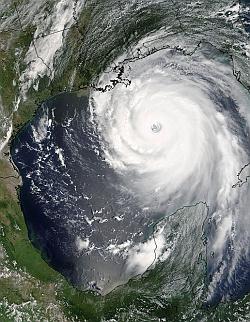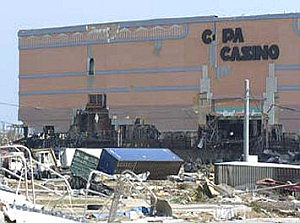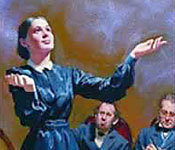|
< Prev 1 2 3 4 5 6 Next >
Crime and Natural Disasters to Increase
 |
 |
Hurricane Katrina heads to
New Orleans.—NASA. |
|
Judgments Upon Immorality
"Yet the hearts of men are hardened." Not everyone is hardened. There are those who, even before
Katrina hit, heard the Spirit of God speaking softly to their hearts. Take for example the following
excerpt from a news story that appeared around the world:
|
Tourists stranded . . .
Tina and Bryan Steven, of Forest Lake, Minn., sat glumly on
the sidewalk outside their hotel in the French Quarter.
"We're choosing the best of two evils," said Bryan Steven.
"It's either be stuck in the hotel or stuck on the road. ...
We'll make it through it."
His wife, wearing a Bourbon Street T-shirt with a lewd message,
interjected: "I just don't want to die in this
shirt."—"Katrina
Heads for New Orleans," Aug. 29, 2005.
|
|
Yet, unlike Tina, not everyone was thinking of repentance. When the storm had not quite totally
passed, others were thinking of partying instead. From another news story carried by hundreds of news
outlets:
|
Gail Henke could think of no better way to celebrate the French
Quarter's survival of Hurricane Katrina than to belly up to a
bar on Bourbon Street with a vodka and cranberry juice. Call
it a libation to the storm gods.
"You know what? There's a reason why we're called the Saints,"
the 53-year-old tour booker said Monday as she communed with 20 or so other survivors.
"Because no matter what religion you are, whether you're a Catholic, whether you're voodoo,
whether you're Baptist or so on, so on, and so on — we all pray. We all pray.
"I'm not a religious fanatic. But God has saved us." . . .
After the storm passed, police circled the quarter with bullhorns
shouting: "The French Quarter is closed. This is state of emergency.
Please, please get off the streets or you will be detained."
But that couldn't dampen the indomitable spirit of one of the
nation's most famous — and infamous — neighborhoods.
Tamara Stevens, 45, and her boyfriend Rick Leiby, 65, found their
way to Johnny White's Sports Bar before the winds even stopped blowing.
After spending a harrowing night in their swaying apartment, they needed to be out among people.
"This place will still be here," Leiby, a tour guide, said as
he sipped a screwdriver from a plastic cup. "And it ain't gonna
quit."—"French
Quarter battered but unbowed," Aug. 29, 2005.
|
As the above news report said, the French Quarter is both famous and infamous, and its infamy
isn't due just to drinking, living together, and wearing shirts with lewd messages. When we first moved to the
New Orleans area about 1976, Dad drove down Bourbon street with the family. We don't recall driving
down there again. It's not a place you drive down in broad daylight with kids in the car.
And then there's Southern Decadence, an annual Labor Day festival that would have started
just two days after Katrina hit. As SouthernDecadence.net said before
their New Orleans servers went down:
|
Southern Decadence started thirty-four years ago . . . .
One of the largest annual celebrations in New Orleans, it has
become known as the "Gay Mardi Gras." . . . With
over 100,000 gay, lesbian, bisexual and transgender participants
last year, the economic impact on the city was estimated to be
in excess of $95 million. Mayor Ray Nagin has recognized its
importance with an Official Proclamation to welcome the event.
The city's wildest neighborhood gets
even crazier as the French Quarter is packed for the entire event . . . .
The theme [for 2005] is "Jazz and Jezebels" and the colors are red and purple.
The corner of Bourbon and St. Ann Streets is generally considered
to be the epicenter of Gay New Orleans, and even more so during
the Southern Decadence festival weekend. At that intersection
is the largest gay nightclub, The Bourbon Pub video bar and The
Parade dance club, which is home to the hottest dancers in town.
. . . Most of the city's main gay attractions are
located within a few blocks of this intersection.
|
Murder
But it wasn't only sexual immorality that New Orleans was known for. Take for example the following article,
which appeared across the country just eleven days before Katrina hit:
|
New Orleans murder rate on the rise again
Homicide rate nowhere near ’94 peak but still 10 times national average
NEW ORLEANS — Last year, university researchers conducted an
experiment in which police fired 700 blank rounds in a New Orleans
neighborhood in a single afternoon. No one called to report the gunfire.
New Orleans residents are reluctant to come forward as witnesses,
fearing retaliation. And experts say that is one of several reasons
homicides are on the rise in the Big Easy at a time when other
cities are seeing their murder rates plummet to levels not seen in decades.
. . . in recent
years, the city's homicide rate has climbed again to nearly 10
times the national average. . . .
There had been 192 this year by mid-August, compared
with 169 at the same time in 2004. Adjusted for the city's size,
those numbers dwarf murder rates in Washington, Detroit, Baltimore,
Atlanta, Chicago, Los Angeles and New York City. . . .
Only one in four people arrested in the city for murder is eventually
convicted, according to a recent study by the New Orleans Police Foundation, a private nonprofit group.
According to the study, 42 percent of serious crime cases reviewed
by prosecutors — about 22,000 — were turned away between 2002
and 2004 because the cases were not deemed suitable for court.
District Attorney Eddie Jordan said the lack of eyewitness testimony
was one reason for the dropped cases. New Orleans has had such
a problem with retaliation against witnesses — including murder
— that the district attorney's office took the unusual step of
starting a local witness protection program.
Witnesses may also be reluctant to talk to police because of
the department's struggles with allegations of brutality and corruption. . . .
But recently, complaints about police brutality have surfaced
again.—Aug. 18, 2005.
|
The situation had obviously gotten extremely out of hand,
in neighborhoods other than just the French Quarter.
 |
 |
Hurricane Katrina destroyed Copa Casino
in Gulfport, MS.—GulfCoastNews.com. |
|
Gambling
New Orleans was spared a direct hit as Katrina veered east. Not that it mattered much, as things turned out.
But that veering didn't help the Mississippi Gulf Coast any.
When we lived down that way there were no casinos in Gulfport or Biloxi, but in the years that
have passed casinos in those cities have turned into a $2.7 billion-a-year industry. 14,000 workers in
12 or so casinos, generating half a million a day in ill-gotten tax revenue for the state of Mississippi. And
Katrina wiped it all out.
Were those involved in such vice taking all this as Providence's cue that it's time to pursue another
line of work? Undoubtedly some were, but not everyone. State gambling officials and casino executives,
just days after the hurricane, talked about getting the Mississippi legislature to enact special
legislation to keep their "industry" alive. Wouldn't it have been smarter to at least wait until
after hurricane season before tossing around such ideas?
Come to think of it, if as a society we want to live dissolute lives, why do we build our
Sin Cities below sea level, our Sodoms on fault lines, and our casinos on the Gulf Coast?
Does it not appear that we are daring God to destroy us when we purposely build our centers of sin
in such obviously vulnerable places?
< Prev 1 2 3 4 5 6 Next >
|



